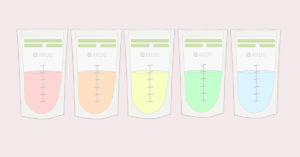
There are SO many colors of breast milk it can be quite shocking for new moms. When you’re used to seeing your breast milk appear one color and suddenly it’s a completely different color, there’s a reason for that! Most of the time, breast milk is clear, white, blue-tinged, cream, tan, or yellow; however, change in your breast milk color is often caused by foods, supplements, or medication you ingest. Below is a breakout of some of the typical colors and typical causes.
Dark yellow breast milk
Did you know that your breast milk typically changes color if your baby gets an illness? Mothers often notice that their milk has a deeper yellow appearance when their baby is sick. When your baby breastfeeds, it creates a vacuum in which some of your baby’s saliva gets ‘backwashed’ into your nipple. There, it is believed that mammary gland receptors interpret your baby’s spit for bacteria and viruses. If any pathogens are detected, your body responds by sending antibodies into your milk, changing the immunological composition of your milk to help your baby fight those pathogens and thus changing the color of your milk. Your body is pretty incredible, isn’t it?!
Green breast milk
This is a color that is often caused by diet. Foods that are strong in green coloring are known to cause a green tint to breast milk. If you’re a salad eater or green juice drinker, this could become your normal coloring. This is completely normal and nothing to be concerned about!
Pink, orange or red breast milk
Similar to green foods causing green breast milk, colored foods are usually the culprit for pink, orange or red tinted breast milk. Beets, red, yellow, or orange food dies, blood oranges, and really anything with a strong color that also may affect the color of your urine can change the color of your breast milk. Does your pee turn a neon yellow after taking your multivitamin? Chances are, your milk is also changing color. You’ll be happy to hear that none of these are causes for worry!
Blood in your breast milk or “rusty pipe” syndrome
If you notice your breast milk has gone from “clean” looking to “rusty” looking, it’s usually caused by blood getting into your milk ducts. Rusty pipe syndrome occurs when old blood is left in your milk ducts after your breasts have been engorged. Often, your milk will look like dirty water from an old rusty pipe. Most of the time, this is nothing to worry about and clears up on its own within a few days. If you notice blood streaks in your milk, it could be caused by cracked nipples. If you do have cracked nipples, you’ll know that they hurt like the dickens! Neither is cause for alarm but your breast milk doesn’t revert back to its normal color after a week, it’s time to call your doctor.
Black Breast milk
Occasionally, mother’s breast milk may turn a dark brown or even black. It’s usually caused by an acne treatment antibiotic called Minocin (minocycline) that should not be taken while breastfeeding. It is always very important to let your doctor know you’re breastfeeding and you can even contact the Infant Risk hotline to make sure any medications you are taking are safe to use while breastfeeding.
When to call the doc
Most of the time, changes in breast milk color are normal and nothing to worry about. However, if there is pain associated with the change of color or you feel there is something more to be concerned about, please call your physician or a lactation consultant right away. When you notice your breast milk has changed color, try to think back on your diet or notice if you’re little one is starting to feel a little off. Most importantly, none of these colors are signs to stop breastfeeding. Your baby can continue at the breast as often as before and if they are starting to get a little sick, it’s even more important. Remember, you provide their defense and additional tailored antibodies!
Good luck on your breastfeeding journey and if you have any additional questions or have a topic you’d like to see us address please feel free to reach out.
